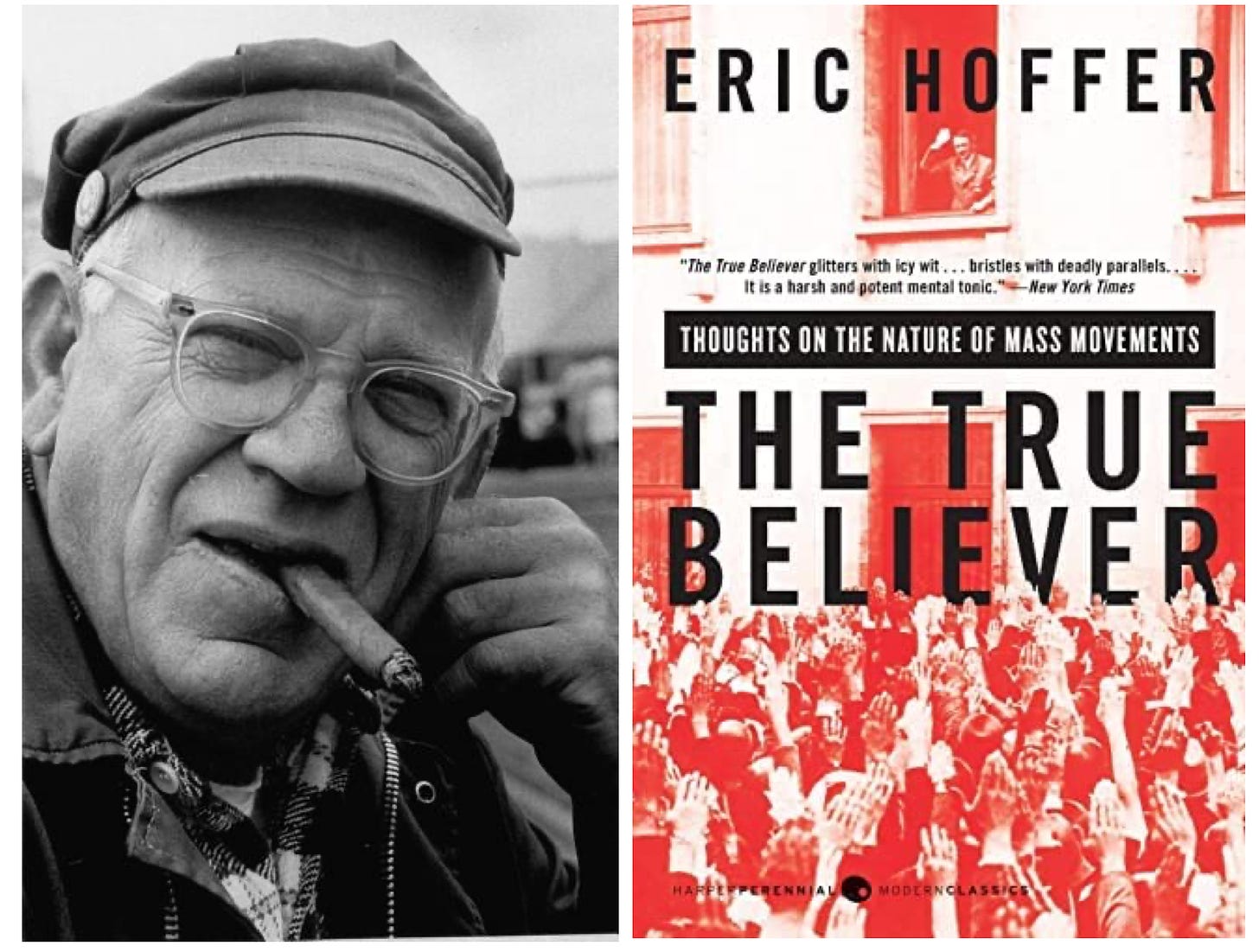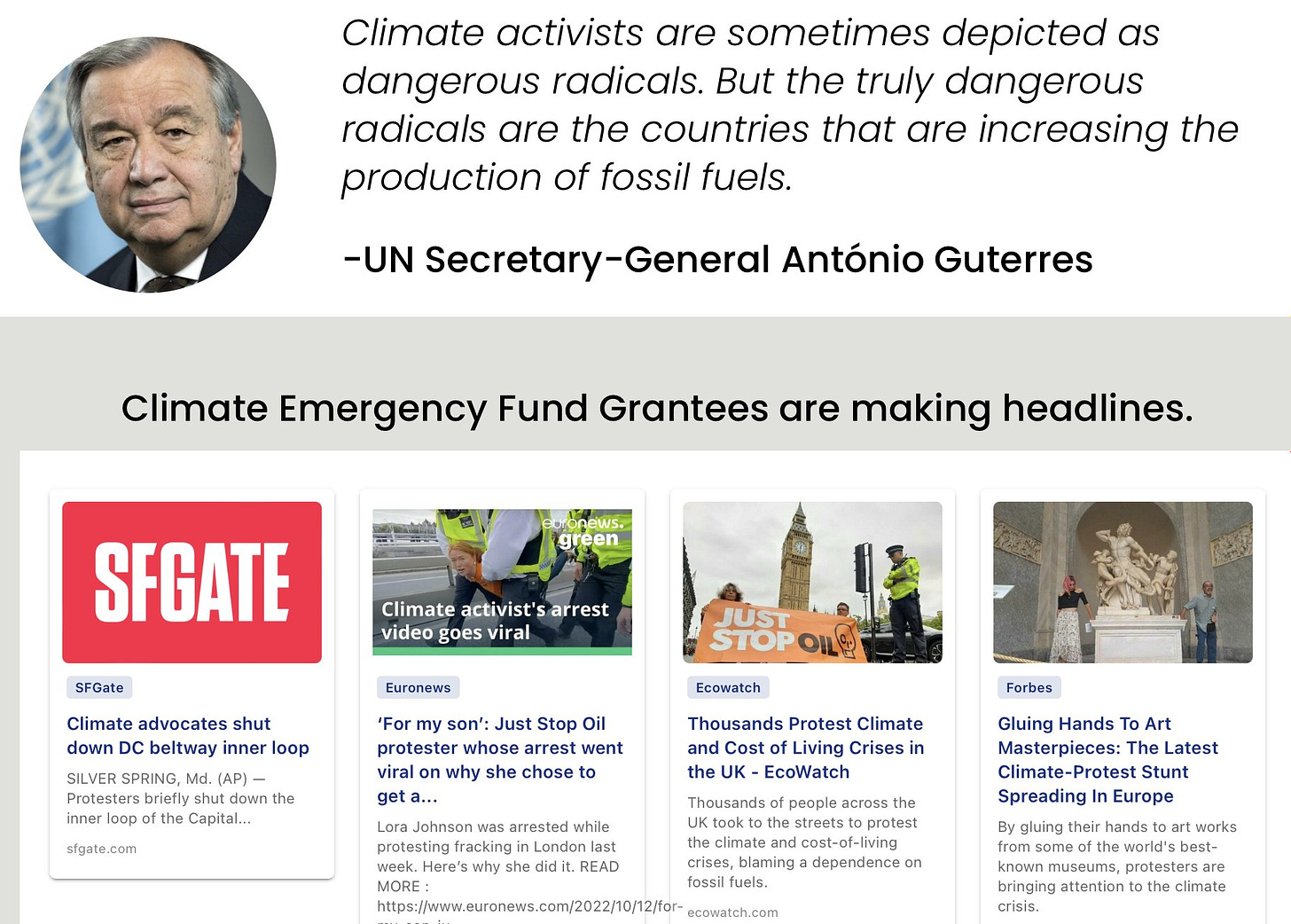The Quiet Desperation Of Woke Fanatics
What's driving them? And how can they be defeated?

“The fiercest fanatics are often selfish people who were forced, by innate shortcomings or external circumstances, to lose faith in their own selves. They separate the excellent instrument of their selfishness from their ineffectual selves and attach it to the service of some holy cause.”
— Eric Hoffer, The True Believer
Over the last few weeks, climate activists in Britain have blocked highways (because cars emit carbon dioxide), poured milk onto the floors of supermarkets (because livestock emits methane), and thrown tomato soup at Van Gogh’s “Sunflowers” (because climate change is more important than art. Or something). The activists are a kind of reboot of the Extinction Rebellion (XR) climate protests in the UK in the fall of 2019.
People in the UK are at risk of dying from natural gas shortages. Still, the climate activists with “Just Stop Oil” think it’s outrageous that their government is desperately trying to produce more natural gas for its people. But without more natural gas, there could be three-hour-long blackouts, which threaten the operation of medical equipment, and thus the lives of vulnerable people.
The various media stunts appeared authentically grassroots but were, in fact, financed by a $1 million grant from a philanthropic group called Climate Emergency Fund, which is funded by their heirs to the Getty and Rockefeller oil fortunes, and founded in 2019. The Board of Directors consists of a who’s-who of climate alarmism including “Don’t Look Up!” film director, Adam McKay, who donated $4 million, New Yorker writer Bill McKibben, and New York Times columnist David Wallace-Wells. The Fund and their grantees have been cheered on by the Secretary General of the United Nations and much of the mainstream media.
In a series of recent articles I have argued that what lies behind climate fanaticism and narcissism is an apocalyptic religion born from nihilism. The power of science to explain humankind’s place in the universe (e.g., the big bang, evolution by natural selection) resulted in a dominant narrative coming out of society’s elite institutions for over 100 years that human life has no inherent meaning or purpose (nihilism). We’re just animals like any other.
This depressing story has led the ostensibly secular elite, which are educated and indoctrinated in universities that teach nihilism as unquestioning scientific gospel, to create a new apocalyptic religion (climate catastrophe), complete with a new victim-god (nature), a new reason for guilt (sins against nature), and a path for redemption (renewables and low-energy living). It, and the broader Woke religion, have found intellectual ballast since World War II from Rousseau, Malthus, and Foucault.
But that account only partly addresses the motivations of the fanatics. It doesn’t answer why some people become fanatics and others don’t. It doesn’t explain the specific role of fanatics, particularly in relation to other actors, such as the intellectual architects of the movement, and the institution-builders. Nor does it address how fanaticism ends and what, if anything, can be done to hasten its expiration date.
As such, we need to ask, who exactly are the climate fanatics? And how can their power over Western cultural and political life be reduced?
The Psychology Of Fanaticism

All mass movements have certain things in common, argues Eric Hoffer in his now-classic 1951 work of political psychology, The True Believer. Hoffer was mostly describing Nazis and Communists but his observations are incredibly fresh and relevant. I devoured most of the book in a single sitting and underlined many sentences and shouted to myself “Yes! That’s it!” as I reflected on how well it described climate fanaticism and Woke fanaticism more broadly. While at times Hoffer can sound reactionary, he was himself working-class, laboring as a longshoreman (stevedore), and he is writing in defense of liberal democracy, not pining for a return to the aristocracy.
Hoffer argues that fanaticism is born from personal frustration. Fanatics are people with more ambition than talent. Notes Hoffer, “most of the Nazi bigwigs had artistic and literary ambitions which they could not realize. Hitler tried painting and architecture; Goebbels, drama, the novel and poetry; Rosenberg, architecture and philosophy; von Schirach, poetry; Funk, music; Streicher, painting. ‘Almost all were failures, not only by the usual vulgar criterion of success but by their own artistic criteria.’”
You can see the connection to wounded pride. Many narcissists are seeking to feel relevant but lack the talent or stamina to become any good at their craft. They must thus resort to cruder actions that require courage but little creativity, or hard work, like throwing a can of tomato soup onto a Van Gogh painting, stopping traffic, or emptying milk onto the floor. It is notable the extent to which the first and last of those behaviors are typical of the temper tantrums of children. Konstantin Kisin aptly dubbed the climate fanatics as belonging to “tantrum groups.”
For Hoffer, the fanatic pursues politics for the same reason an addict pursues drugs: to escape inner demons. “The burning conviction that we have a holy duty toward others is often a way of attaching our drowning selves to a passing raft,” he notes. “What looks like giving a hand is often holding on for dear life. Take away our holy duties and you leave our lives puny and meaningless… in exchanging a self-centered for a selfless life we gain enormously in self-esteem. The vanity of the selfless, even those who practice utmost humility, is boundless.”
All mass movements are religious movements, says Hoffer. Both the swastika and the hammer and sickle are versions of the cross. “The ceremonial of the parades is as the ceremonial of a religious procession.” Such movements aren’t only religious; they can be nationalistic or communistic, too. But they are movements offering the feeling of immortality to their true believers. Today we can see such religious rituals in the kneeling promoted by Black Lives Matter activists including (or especially) in secular places like uber-woke Martha’s Vineyard.
Harsh as it sounds, fanatics tend to be losers. They are those with the least to gain from the status quo and the most to gain from radical change. “The reason that the inferior elements of a nation can exert a marked influence on its course is that they are wholly without reverence toward the present,” he writes. “They see their lives and the present as spoiled beyond remedy and they are ready to waste and wreck both; hence their recklessness and their will to chaos and anarchy.” Hoffer doesn’t mince words. He goes so far as to refer to fanatics as the slime that serves as the mortar for building a castle.
It is worth noting that Hoffer is not suggesting that there is never a role for outcasts. America was founded, after all, by them. “The stone the builders reject becomes the cornerstone of a new world. A nation without dregs and malcontents is orderly, decent, peaceful, and pleasant, but perhaps without the seed of things to come. It was not the irony of history that the undesired in the countries of Europe should have crossed an ocean to build a new world on this continent. Only they could do it.”
The first fanatics tend more often to be bored elites than exploited or oppressed victims, writes Hoffer. But this is a “boredom” of nihilists. “The consciousness of a barren, meaningless existence is the main fountainhead of boredom,” he writes. Such people lack the experience of “flow” that comes from being engaged in absorbing, meaningful work. Disruptive activism offers a kind of high. It’s the feeling of power that comes from breaking the rules. “The rules are for thee, not me,” says the law-breaker. For some, like Prince Harry and Duchess Megan Markle, who keep getting caught jet-setting to UN climate conferences, the hypocrisy is the point.
Other fanatics are oblivious to their privilege. Last month, a 16-year-old climate activist in New Zealand told a radio journalist that people should have to apply to take gas-guzzling flights. Under her rules, the reporter asked, would people be “allowed to go to Fiji”? Said the activist, “In the current climate crisis I don’t think that that’s necessary.” After the reporter asked what the last place she had flown to was, the 16-year-old admitted it was Fiji. Stressed the teenager, “Of course, I’m not embarrassed.”
In addition to attracting teens, the ennui of everyday life attracts church lady types — something I found in my research into XR in 2019. “Boredom accounts for the almost invariable presence of spinsters and middle-aged women at the birth of mass movements,” finds Hoffer. Such was also the case with the birth of the anti-nuclear and “population control” movement of the 1960s and 1970s.
Conversely, marriage cuts against activism because it offers women a “new purpose in life, a new future, and a new identity… The boredom of spinsters and of women who can no longer find joy and fulfillment in marriage stems from an awareness of barren, spoiled life…. Hitler made full use of ‘the society ladies thirsting for adventure, sick of their empty lives, no longer getting a ‘kick’ out of love affairs.”
Who, then, are the climate fanatics? They are frustrated, needy, and lonely. They are in the grip of nihilism and wounded, narcissistically. They are spiritual seekers and creative failures. They have both a strong need to feel special, and powerful, but also to lose themselves in the group. They are people who desperately want to get away from having to deal with themselves and the confrontation with inner demons required for personal growth.
How Fanaticism Ends

Not everything Hoffer describes about the fanatic rings true. Hoffer famously concludes, “A movement is pioneered by men of words, materialized by fanatics and consolidated by men of actions.” First come the intellectuals like Rousseau, Malthus, and Foucault. Then come the climate fanatics like XR and Just Stop Oil. And last come the “men of action” who will consolidate the movement into institutions. “Once the stage is set,” Hoffer writes, “the presence of an outstanding leader is indispensable.” In reality, there’s no linear progression. The Malthusian and climate apocalyptic institutions (e.g., Greenpeace, Sierra Club, NRDC) have existed for over a half-century. Lenin was as much a man of action as Stalin.
Hoffer argues that fanaticism emerges during periods of profound social, economic, and political crisis, but Martin Gurri argues persuasively in his essential 2018 book, Revolt of the Public, that the radical protests in recent years were unleashed by social media, which are as disruptive as the invention of the printing press. Black Lives Matter started in 2015, when America had a black president, and the economy was six years into recovery. There was no economic crisis in 2019 when XR shut down much of London; in fact, it was booming. The case could be made that Brexit and the election of Trump fueled the climate protests. But it’s not the case that they created Black Lives Matter, which had more to do with the penetration of social media, which allowed for videos of police violence to go viral.
And fanatical leaders come and go. Greta Thunberg today appears positively passé, authoring books and acting like a very serious person for German television, even endorsing nuclear as an alternative to coal. She’s no longer on the cutting edge. Thunberg even implied she felt embarrassed by the fanatical rhetoric of her you-stole-my-childhood tantrum (“How dare you!”) at the U.N. three long years ago. And, dangerously for her future as a fanatic, she said she was happy. Thunberg is thus on the same long road as Al Gore to irrelevancy.
Those quibbles aside, Hoffer correctly identifies the most effective way to counter a fanatical, mass movement, in my view.
Source: Michael Shellenberger



No comments:
Post a Comment